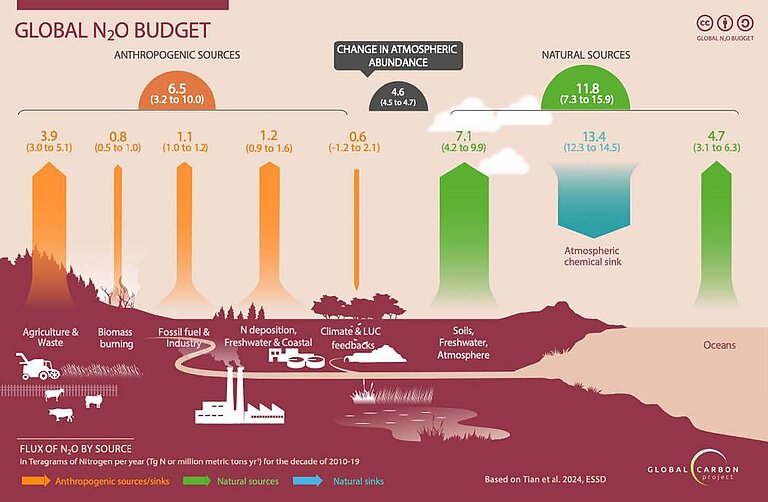Nitrous Oxide Emissions at Record High
GEOMAR database provides critical oceanic data for global N2O budget
Nitrous oxide (N2O), commonly known as laughing gas, is a colourless gas in the group of nitrogen oxides and is an extremely potent greenhouse gas, with a global warming potential about 300 times that of carbon dioxide (CO2). A recent study conducted for the Global Carbon Project, led by Boston College in Chestnut Hill, Massachusetts, USA, shows a 40 percent increase in global N2O emissions over the four decades from 1980 to 2020. This development has serious implications for the planet.
Agriculture was responsible for 74 percent of anthropogenic nitrous oxide emissions in the 2010s, mainly due to the use of synthetic fertilisers and animal manure on cropland, according to the Global Nitrous Oxide Budget 2024 report, recently published in the journal Earth System Science Data. Another major source is the ocean and adjacent coastal areas.
The comprehensive study of nitrous oxide emissions and sinks is based on millions of measurements taken on land, in the atmosphere, in freshwater systems, and in the ocean. An international team of 58 researchers from 15 countries compiled these measurements, resulting in the most extensive assessment of the global N2O budget to date.
At a time when greenhouse gas emissions must be drastically and rapidly reduced to limit global warming, the study shows that more nitrous oxide was emitted in 2020 and 2021 than ever before in history. Excess nitrogen burdens soil, water, and air. In the atmosphere, N2O destroys the ozone layer and exacerbates climate change through its powerful greenhouse effect. In addition to emissions from soils, the ocean and adjacent coastal areas are a major source of atmospheric N2O.
Data from the GEOMAR Helmholtz Centre for Ocean Research Kiel were used to estimate oceanic nitrous oxide emissions. GEOMAR operates the world's largest database of N2O measurements from the ocean and adjacent coastal areas. Its name, MEMENTO (Latin for “remember!”), stands for MarinE MethanE and NiTrous Oxide.
“Human-induced nitrous oxide emissions must be reduced to keep global warming below the two-degree threshold of the Paris Agreement,” emphasises the report’s lead author, Dr Hanqin Tian, professor of global sustainability and director of the Centre for Earth System Science and Global Sustainability at the Schiller Institute for Integrated Science and Society at Boston College. “There are currently no technologies to remove nitrous oxide from the atmosphere.”
According to Dr Hermann Bange, Professor of Marine Biogeochemistry at GEOMAR and head of the Trace Gas Biogeochemistry Research Group, the international study is a milestone because it describes the global sources and sinks of nitrous oxide in unprecedented detail. Effective action to reduce emissions requires a thorough understanding of these sources and sinks.
The researchers therefore call for more frequent assessments of the N2O budget and recommend the establishment of a global N2O measurement network. “The ocean is one of the largest sources of nitrous oxide and must be included in this network,” says Professor Bange.
Original Publication:
Tian, H. et al (2023): Global Nitrous Oxide Budget 1980-2020, Earth Syst. Sci. Data Discuss. Global Carbon Project.
Article DOI: 10.5194/essd-2023-401
Additional Data DOI: 10.18160/RQ8P-2Z4RDOI:
Background to the Global Carbon Project:
Founded in 2001, the Global Carbon Project (GCP) is an international research project established to work with the international scientific community to build a shared and agreed knowledge base to support policy debate and action to slow down and ultimately halt the rise of greenhouse gases in the atmosphere. Its projects include global budgets for the three dominant greenhouse gases – carbon dioxide (CO2), methane (CH4) and nitrous oxide (N2O) – and complementary efforts on urban, regional, cumulative, and negative emissions.

Simplified infographic of the global N2O budget. Graphic: Global Carbon Project
![[Translate to English:] Eine Frau mit roter Mütze auf dem Schiff hält ein braunes Probenfläschchen in die Höhe](/fileadmin/_processed_/f/9/csm_BE_Evelyn_N2O_Sampling_GEOMAR_e048b7db3e.jpg)
Sampling on the LITTORINA: GEOMAR operates the world's largest database for N2O measurements from the ocean. Photo: Annette Kock


